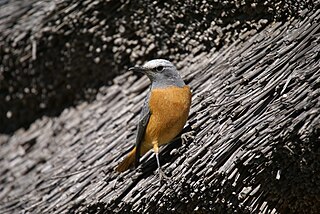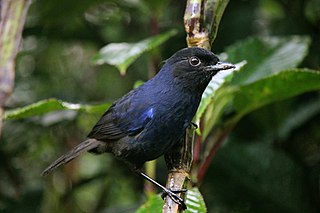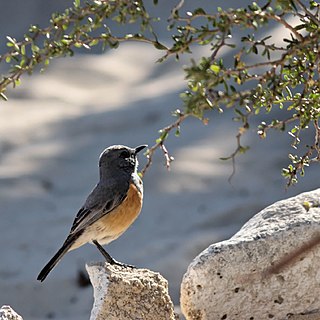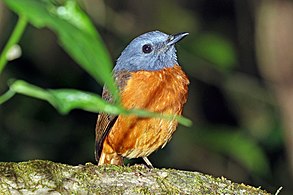
The orange-headed thrush is a bird in the thrush family.

The rock thrushes, Monticola, are a genus of chats, medium-sized mostly insectivorous or omnivorous songbirds. All are Old World birds, and most are associated with mountainous regions.

The common rock thrush, also known as rufous-tailed rock thrush or simply rock thrush, is a chat belonging to the family Muscicapidae. It was formerly placed in the family Turdidae. The scientific name is from Latin. Monticola is from mons, montis "mountain", and colere, "to dwell", and saxatilis means "rock-frequenting", from saxum, "stone".

The blue rock thrush is a species of chat. This thrush-like Old World flycatcher was formerly placed in the family Turdidae. It breeds in southern Europe, northwest Africa, and from Central Asia to northern China and Malaysia. The blue rock thrush is the official national bird of Malta and was shown on the Lm 1 coins that were part of the country's former currency.

The Sri Lanka whistling thrush is a whistling thrush in the family Muscicapidae. It is a resident endemic bird in Sri Lanka.

The blue-capped rock thrush is a species of bird in the family Muscicapidae.

The Cape rock thrush is a member of the bird family Muscicapidae. This rock thrush breeds in eastern and southern South Africa, Lesotho and Eswatini. It is a common endemic resident, non-migratory apart from seasonal altitudinal movements in some areas.

Montagne d'Ambre National Park is a national park in the Diana Region of northern Madagascar. The park is known for its endemic flora and fauna, water falls and crater lakes. It is 1,000 km (620 mi) north of the capital, Antananarivo and is one of the most biologically diverse places in all of Madagascar with seventy-five species of birds, twenty-five species of mammals, and fifty-nine species of reptiles known to inhabit the park.

Eversmann's redstart, also known as the rufous-backed redstart, is a passerine bird belonging to the genus Phoenicurus. It was formerly classified in the thrush family Turdidae but is now placed in the Old World flycatcher family Muscicapidae. It was described by the German biologist Eduard Friedrich Eversmann who is commemorated in the bird's English name.

Hose's broadbill is a species of bird in the family Calyptomenidae. It was described by the British naturalist Richard Bowdler Sharpe in 1892 and is named after the British zoologist Charles Hose, who collected the holotype of the species. It is 19–21 cm (7.5–8.3 in) long, with females weighing 92 g (3.2 oz) on average and males weighing 102–115 g (3.6–4.1 oz). Males are bright green and have conspicuous black spots on the wings, black markings on the head, blue underparts, black flight feathers, and a large green tuft covering most of the bill. Females have smaller forehead tufts, lime-green underparts with sky blue instead of azure blue on the undertail coverts, and lack black markings on the head, except for a black spot in front of the eye.

The white-headed robin-chat is a species of bird in the family Muscicapidae. It is found in northern Angola and the western Democratic Republic of the Congo. It is threatened by habitat loss, and its IUCN conservation status is the least concern.

Benson's rock thrush is a songbird in the family Muscicapidae, formerly placed in the Turdidae together with the other chats. It is usually included in the forest rock thrush as a subspecies; e.g. BirdLife International revised its status to subspecies in 2008., however it was recognized as a distinct species at one time.

The white-throated rock thrush is a species of bird in the family Muscicapidae of the order Passeriformes.

The littoral rock thrush, is a species of bird in the family Muscicapidae. It is endemic to Madagascar.

The chestnut-bellied rock thrush is a species of bird in the family Muscicapidae.

The little rock thrush is a passerine bird in the family Muscicapidae. It is found in Eritrea, Ethiopia, Kenya, Oman, Saudi Arabia, Somalia, South Sudan, Tanzania, Uganda, and Yemen. It is found in rocky areas with some trees, and sometimes near settlements. At 15 to 16 centimetres this is the smallest of the Muscicapidae. The male has the head, throat and upper mantle blue-grey, the underparts orange-red, except for the center blackish center tail and tips which form an inverted T shape. The female is duller and paler. It is readily mistaken for a redstart because of its habit of trembling its tail.

The forest rock thrush is a songbird in the family Muscicapidae, formerly placed in the Turdidae together with the other chats. It now includes Benson's rock thrush and Amber Mountain rock thrush as subspecies.

The Malayan whistling thrush or Malaysian whistling-thrush is a species of bird in the family Muscicapidae. It is endemic to the Malay Peninsula. Due primarily to habitat loss, its population is thought to be in decline.

The orange ground thrush is a species of bird in the family Turdidae.

The Aztec thrush is a species of bird in the family Turdidae. It is found mainly in Mexico, but vagrants are occasionally seen in the United States. Its natural habitat is montane forests. The IUCN Red List denotes it as a least-concern species.
























